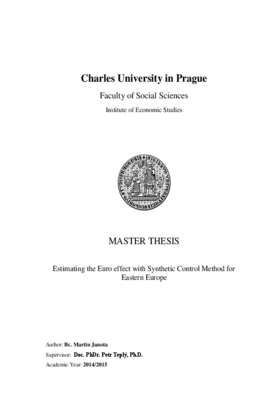Estimating the Euro effect with Synthetic Control Method for Eastern Europe
Estimating the Euro effect with Synthetic Control Method for Eastern Europe
diplomová práce (OBHÁJENO)

Zobrazit/
Trvalý odkaz
http://hdl.handle.net/20.500.11956/62586Identifikátory
SIS: 150465
Katalog UK: 990020107020106986
Kolekce
- Kvalifikační práce [19618]
Autor
Vedoucí práce
Oponent práce
Vošvrda, Miloslav
Fakulta / součást
Fakulta sociálních věd
Obor
Ekonomie
Katedra / ústav / klinika
Institut ekonomických studií
Datum obhajoby
22. 6. 2015
Nakladatel
Univerzita Karlova, Fakulta sociálních vědJazyk
Angličtina
Známka
Výborně
Klíčová slova (česky)
euro, synthetic control method, příjem per capita, růst HDP, Evropská Unie, přijetí měnyKlíčová slova (anglicky)
euro, synthetic control method, income per capita, GDP growth, European Union, currency adoptionOdhad efektu zavedení eura pro Východní Evropu pomocí Synthetic Control metody Abstrakt Tato práce odhaduje efekt zavedení Eura na nejnovější členy Eurozóny pomocí synthetic control metody. Efekt je odhadován na HDP per capita a na růstu HDP. Odhady ukazují celkově nerozhodný efekt pro Slovensko a Maltu, neutrální efekt pro Estonsko a negativní efekt pro Slovinsko a Kypr. Náklady zavedení Eura pro Kypr jsou odhadovány až do výše 1/3 HDP per capita. V některých případech se směr efektu změnil po finanční krizi. Rozhodnost závěrů je ovlivněna malým počtem pozorování. Práce diskutuje předpoklady použití metodologie se závěrem, že kvalita dat pravděpodobně výrazně zkresluje výsledky.
Estimating the Euro effect with Synthetic Control Method for Eastern Europe Abstract This thesis estimates the effect of Euro adoption on newest Eurozone members using synthetic control method. The effect is estimated on income per capita and GDP growth. Estimates indicate overall indecisive effect for Slovakia and Malta, neutral effect for Estonia and negative effect for Slovenia and Cyprus. The cost of Euro for Cyprus is estimated to be as high as 1/3 of GDP per capita. In some cases the direction of the effect changed before and after the financial crisis. The quality of inference suffers from low number of observations. Methodological assumptions are discussed, concluding that quality of Eastern European time series likely causes substantial bias in the results.
